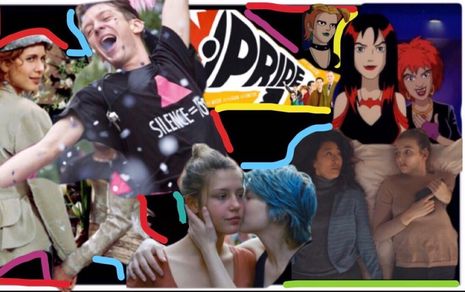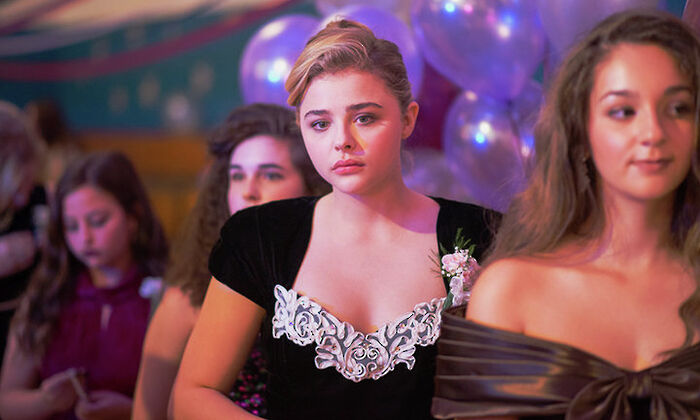Pride Month: Taking Pride in Representation
Tilda Butterworth and Alex Jarvis reflect on the representation of LGBTQ+ groups in film and how it has changed over the course of years.

Any LGBTQ+ person will know the pain of wasting hours on terrible films and television series just to see one queer storyline or character. A few years ago, that was me – I worked through what was probably every low budget indie lesbian film that exists, and once even saw a film that had such low production value that the first item on the credits read “Insert Title Text Here”. I (Tilda) remember my friendship group, at the age of 13, obsessively watching Skins because of the lesbian representation in the form of Naomi and Emily. Years later, in the final episode of the entire series, Naomi was unexpectedly and unnecessarily killed off. By that time, we weren’t so reliant on what her character provided for us, but it was still a blow to watch a character who had once been so important to us completely tossed aside.
For me (Alex), being gay was something that I had only vaguely considered when I was young. I thought little about it, really - even less about LGBTQ+ representation in television, or, rather, the lack of it. Still, there were certainly some early indicators - my obsession with the Hex Girls from Scooby Doo should have at least flagged something for my parents, but, alas. The earliest outright reference that I remember is of Carol and Susan in Friends, packaged alongside Ross’ constant belittling and Chandler’s constant phobia of being perceived as gay. God forbid.
"Film is a mirror that helps us better comprehend our situation, and seeing ‘yourself’ in film is so important"
Just a few years ago there was virtually no space to productively explore the possibility of anything outside of the heterosexual norms, simply because there were no tv shows or films where same-sex relationships were addressed explicitly. Film is a mirror that helps us better comprehend our situation, and seeing ‘yourself’ in film is so important. It was certainly important to me during those turbulent adolescent years. Hell, it took watching Killing Eve recently for me to get that you don’t have to understand yourself completely by the time you turn 20, or 30, or 40 - also that being gay doesn’t mean you can’t be an internationally-renowned Russian assassin.
Yet, in a world in which LGBTQ+ people are underrepresented everywhere, the representation we are given is usually provided by people with money and power, who fall back on harmful stereotypes because they can’t be bothered to understand the queer reality. The lack of LGBTQ+ representation in the actual process of the creation of cinema and television leads to several problems: the first being a preoccupation with the torturous coming out process or the struggles of being queer. Queer storylines frequently revolve around how apparently burdensome it is to identify as queer, rather than allow characters to have narratives which unfold independently of their sexuality. Aside from this, the same overused tropes seem to crop up again and again: conversion camps, student/teacher relationships, bisexual cheating, and of course, the “Bury Your Gays” trope.
"More and more films are coming out (pun entirely intended) that are representing this spectrum of experience more broadly"
We’re still slow to move away away, too, from the concept of being gay forming part of the punchline, present in several otherwise brilliant films. In Les Intouchables (2011), Driss takes up a job caring for his new employer, whose female assistant he pursues on and off throughout the film. He’s lightly encouraged by the other staff, only to realise at the end that she has a girlfriend called Fred, hence the confusion. Cue laughter.
Continuing the vein of problematic representation, Blue is the Warmest Colour (2013) immediately comes to mind. While the cinematography of the film should be celebrated, I believe that it should never be recommended as a good lesbian romance. A lecherous male gaze is omnipresent (provided by director, Abdellatif Kechiche), and its portrayal of intimacy is cold and distant. In lieu of spending your time watching it, I would recommend some more fulfilling, nuanced lesbian romances: Carol, Portrait of a Lady on Fire, Elisa & Marcela, Mulholland Drive and Disobedience.
A huge issue with the visual representation of LGBTQ+ couples is that the majority are slim, white and attractive – as if ‘conventional’, Eurocentric beauty standards make queerness more palatable. LGBTQ+ people of colour are extremely underrepresented in media which is pushed and advertised, despite the popularity of shows such as Pose and films such as Moonlight. The reality is that there is no one ‘LGBTQ+ relationship’, just as there is no singular straight relationship. There are many more identities that are often overlooked when it comes to filmic presentation - ace, pansexual, and aromantic individuals, for instance.
Media carelessly inserts queer characters into their narratives in order to seem diverse or accepting, favouring outdated stereotypes over exploring the complexities of these characters. It is also used to attract a certain demographic in order to up viewing numbers – aka. queerbaiting. If you’re sick of this too and are searching for films and series which don’t just hint at queer content but actually deliver and portray it in a nuanced and favourable light, it’s worth seeing: Feel Good (Channel 4), Everything Sucks (Netflix), Black Mirror: San Junipero (Netflix) and Euphoria (HBO). And of course, 120 BPM and Pride – the ultimate (if distinctly different) queer empowerment films which simultaneously celebrate the individual and the community.
A lot has changed in the past few years. In fact, five years ago, one could count the media that provided good LGBTQ+ representation on two hands. Now, it would be impossible to mention everything in this article. While there is still much ground to be covered, seeing LGBTQ+ identifying characters is less momentous than it once was. More and more films are coming out (pun entirely intended) that are representing this spectrum of experience more broadly.
LGBTQ+ people of all ages seek comfort in media with queer representation, no matter how inaccurate or flawed that representation might be, because it’s a way of finding relatable characters in a world dominated by heterosexual, cisgender narratives. Being able to see characters navigating similar obstacles to you, means that things seem to straighten out in your head. Figuratively, of course.
 News / Cambridge academics stand out in King’s 2026 Honours List2 January 2026
News / Cambridge academics stand out in King’s 2026 Honours List2 January 2026 Interviews / You don’t need to peak at Cambridge, says Robin Harding31 December 2025
Interviews / You don’t need to peak at Cambridge, says Robin Harding31 December 2025 Comment / What happened to men at Cambridge?31 December 2025
Comment / What happened to men at Cambridge?31 December 2025 News / Varsity’s biggest stories of 202531 December 2025
News / Varsity’s biggest stories of 202531 December 2025 Features / “It’s a momentary expression of rage”: reforming democracy from Cambridge4 January 2026
Features / “It’s a momentary expression of rage”: reforming democracy from Cambridge4 January 2026










